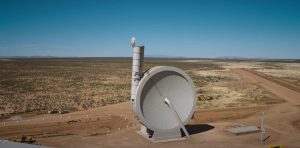SpinLaunch: A New Method of Sending Satellites into Space
By: Edgar Carlos
A new startup company called SpinLaunch is changing the way we send satellites into orbit. The company, which was founded in 2014 by Jonathan Yaney, uses a concept of catapulting satellites into space. The idea may sound bizarre at first, but SpinLaunch is planning to send payloads into space by spinning rockets at a fast velocity and then releasing them into the atmosphere. This concept makes them unique from any other aerospace company, as no one has ever tested an idea this risky before.While the technology and methods of the startup are relatively new, the project is showing promising results so far, indicating a small leap towards zero-emissions space travel. Which will lover the cost of rocket fuel and release less toxic fumes.
What is a suborbital accelerator?
A suborbital accelerator is a machine that is designed to spin objects from 800 to 5,000 mph. The accelerator performs as a first stage of a launch system. A launch system that is not designed yet but will be served to get the projectile into orbit. The primary objective of a suborbital accelerator is to launch the projectile up to a high-enough altitude so that the two rockets from the projectile, which get used in the second stage of the launch system, can place the payload in orbit. The suborbital accelerator works by using a centrifuge in a vacuum-sealed chamber that accelerates the projectile at a certain speed so that the projectile reaches hypersonic speeds once it detaches from the chamber. The centrifuge spins the rocket at a speed of 5,000 mph, then catapultes the rocket out of the chamber. The energy that the suborbital accelerator uses to spin the rocket is powered by renewable resources like solar and wind, which have a lower negative environmental impact than using chemical rockets. This concept of launching a rocket is known to many as a mass accelerator because it utilizes kinetic energy instead of chemical rockets to send second stage rockets into the stratosphere. Once the projectile reaches the stratosphere, the rocket from the projectile ignites until it reaches a speed of 17,500 mph and enters low earth orbit. This is perhaps the most bizarre but eco-friendly method of sending a small payload into space. The suborbital accelerator wont be capable of sending heavy payloads into low earth orbit but it will be able to send a few small satellites without using nearly as much fuel as a typical commercial rocket.
Figure 1

This is an image of the suborbital accelerator in New Mexico.
Source: AutoEvolution
History
While this concept may seem relatively new, it has been around for at least 50 years. Since the early 1960s, NASA has been researching and investigating this technology, decifering whether it can be used as a reliable alternative to rocket launches. However, nfortunately, the technology needed to make suborbital accelerators unfortunately didn’t exist at the time, which is why NASA never continued with it. Although they continued to develop better technology through their space centers. Since then, companies like SpinLaunch have been utilizing this concept. On October 22nd, 2021, SpinLaunch tested its first trial. Inthis trial, they powered the suborbital accelerator up to 20% of its entire power capacity. This amount of power threw a 10-foot projectile tens of thousands of feet into the atmosphere. In the span of two years, Spin Launch conducted their first successful trial and brought its concept to life.
Conclusion
This year, SpinLaunch intends to perform 30 tests of its suborbital accelerator. If all goes to plan, SpinLaunch will begin building its orbital accelerator, which would be capable of sending a payload of roughly 400 pounds into orbit. This would reduce rocket fuel costs and the number of emissions released into the atmosphere. While this idea may be outlandish now, it could soon one day be capable of sending satellites to space in a much cleaner and cost-efficient way.
References and Sources
Houser, K. (2021, December 04). Spinlaunch: Company hurls satellites into space using giant, Spinning Machine. Retrieved January 10, 2022, from https://bigthink.com/the-future/spinlaunch-company-hurls-satellites-into-space-using-giant-spinning-machine/
Novella, S. (2021, December 10). Is Spinlaunch viable – Neurologica blog. Retrieved January 10, 2022, from https://theness.com/neurologicablog/index.php/is-spinlaunch-viable/
Spînu, F. (2021, November 10). Spinlaunch uses kinetic energy to propel vehicle at supersonic speeds for the first time. Retrieved January 24, 2022, from https://www.autoevolution.com/news/spinlaunch-uses-kinetic-energy-to-propel-vehicle-at-supersonic-speeds-for-the-first-time-173859.html
Thesheetztweetz. (2021, November 09). Alternative rocket builder spinlaunch completes First Test Flight. Retrieved January 10, 2022, from https://www.cnbc.com/2021/11/09/spinlaunch-completes-first-test-flight-of-alternative-rocket.html
1 thoughts on “SpinLaunch: A New Method of Sending Satellites into Space”